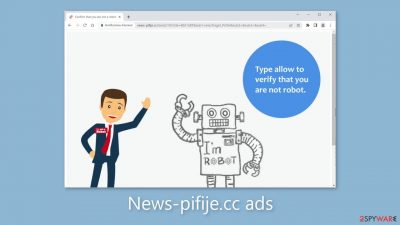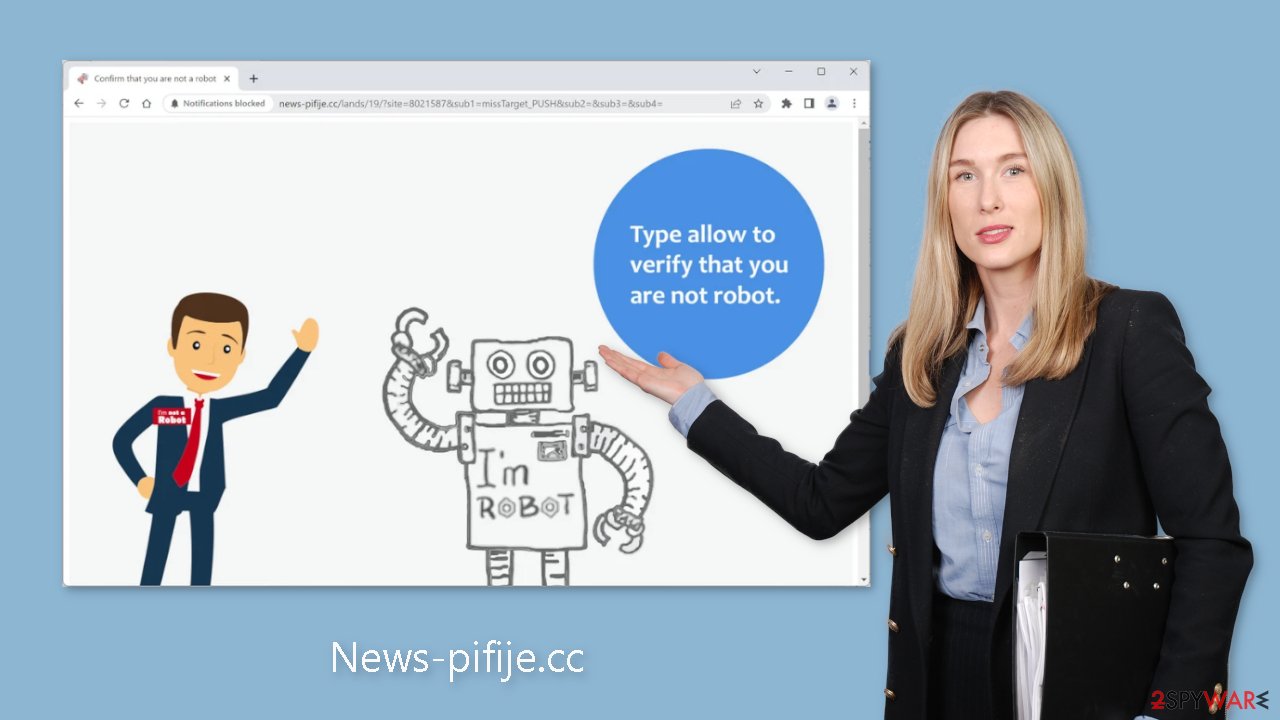News-pifije.cc ads (fake) - Free Instructions
News-pifije.cc ads Removal Guide
What is News-pifije.cc ads?
News-pifije.cc can start spamming users with annoying pop-up ads and generate revenue

News-pifije.cc is a phishing website that uses social engineering[1] techniques to trick users into clicking the “Allow” button. This enables push notifications, which results in annoying pop-up ads that can appear even when the browser is closed. Individuals are prompted to click the button under the guise of confirming that they are not a robot.
The site, however, has no content other than the misleading message and image. Similar messages can be found on websites like Quebbsapone.xyz, Oneadvupfordesign.com, and Pressrestraint.com:
Click Allow to verify that you are 18+
Click Allow to watch the video
Download is ready. Click Allow to download your file
Press Allow to verify that you are not a robot
If you have become a victim of this website and are receiving pop-ups, we recommend that you do not interact with them. Crooks may use rogue advertising networks to display ads that lead to dangerous websites. As a result, people may inadvertently visit scam pages that attempt to obtain personal information or prompt them to download potentially unwanted programs (PUPs)[2] and malware.
| NAME | News-pifije.cc |
| TYPE | Push notification spam; adware |
| SYMPTOMS | Pop-up ads, and banners start appearing on the screen even when the browser is closed |
| DISTRIBUTION | Shady websites; deceptive ads; freeware installations |
| DANGERS | Deceptive advertisements can lead to dangerous websites where users are at risk of giving away their personal information and suffering from monetary losses or downloading malicious software |
| ELIMINATION | Remove website permissions via browser settings or deploy professional security software to detect adware |
| FURTHER STEPS | Use FortectIntego for remediation and fix any damage left |
Distribution methods
Websites such as News-pifije.cc are rarely found in search results and usually lurk on other dubious websites engaged in illegal activities. These unregulated sites are riddled with deceptive advertisements and sneaky redirects. For example, fake “Download” and “Play” buttons are common on illegal streaming sites.[3]
When users are redirected to such spam pages, they may believe that clicking “Allow” will allow them to watch the movie or TV show they have selected. We recommend that you only visit pages that you are familiar with and trust. Clicking on random links and advertisements, even if they appear to promote legitimate products or services, should be avoided.

Adware infections
There is a possibility that the fake website appeared automatically without any user interaction. This can occur when users become infected with adware, which is software that promotes advertising and increases commercial content such as pop-ups, banners, and redirects.
These infections typically occur after the installation of freeware. Without explicit disclosure, freeware distribution platforms frequently include additional programs in their installers. That is why, despite the potentially higher cost, it is best to only use official web stores and developer websites. This could save users money in the long run by ensuring that their systems run smoothly.
Furthermore, always use the “Custom” or “Advanced” installation methods, and read the Privacy Policy and Terms of Service carefully. The most important step is to go through the file list and uncheck the boxes next to any unrelated applications.
Disable the intrusive pop-ups
Push notifications are based on a subscription model so that users can enable and disable them manually in the browser settings. If you need help with the process, follow the guide below:
Google Chrome (desktop):
- Open Google Chrome browser and go to Menu > Settings.
- Scroll down and click on Advanced.
- Locate Privacy and security section and pick Site Settings > Notifications.
![Stop notifications on Chrome PC 1 Stop notifications on Chrome PC 1]()
- Look at the Allow section and look for a suspicious URL.
- Click the three vertical dots next to it and pick Block. This should remove unwanted notifications from Google Chrome.
![Stop notifications on Chrome PC 2 Stop notifications on Chrome PC 2]()
Google Chrome (Android):
- Open Google Chrome and tap on Settings (three vertical dots).
- Select Notifications.
- Scroll down to the Sites section.
- Locate the unwanted URL and toggle the button to the left (Off setting).
![Stop notifications on Chrome Android Stop notifications on Chrome Android]()
Mozilla Firefox:
- Open Mozilla Firefox and go to Menu > Options.
- Click on Privacy & Security section.
- Under Permissions, you should be able to see Notifications. Click the Settings button next to it.
![Stop notifications on Mozilla Firefox 1 Stop notifications on Mozilla Firefox 1]()
- In the Settings – Notification Permissions window, click on the drop-down menu by the URL in question.
- Select Block and then click on Save Changes. This should remove unwanted notifications from Mozilla Firefox.
![Stop notifications on Mozilla Firefox 2 Stop notifications on Mozilla Firefox 2]()
Safari:
- Click on Safari > Preferences…
- Go to the Websites tab and, under General, select Notifications.
- Select the web address in question, click the drop-down menu and select Deny.
![Stop notifications on Safari Stop notifications on Safari]()
MS Edge:
- Open Microsoft Edge, and click the Settings and more button (three horizontal dots) at the top-right of the window.
- Select Settings and then go to Advanced.
- Under Website permissions, pick Manage permissions and select the URL in question.
![Stop notifications on Edge 1 Stop notifications on Edge 1]()
- Toggle the switch to the left to turn notifications off on Microsoft Edge.
MS Edge (Chromium):
- Open Microsoft Edge, and go to Settings.
- Select Site permissions.
- Go to Notifications on the right.
- Under Allow, you will find the unwanted entry.
- Click on More actions and select Block.
Clear your browsers
Following an encounter with a website like News-pifije.cc, it is recommended that you clear your browser's cookies. These are small data files that can store information related to your browsing, such as your IP address, visited links, and online purchases. This information can be sold to advertising networks or other third parties, and in some cases, cookies can be hijacked for malicious purposes.
A maintenance tool like FortectIntego can be used to delete cookies and cache automatically with a single click. In addition, this powerful software can fix most system errors, BSODs, corrupted files, and registry issues, which can be especially useful after a virus infection.
Scan the system for adware
Even after blocking notifications, there is a possibility that adware is still lurking in your system. Adware is a type of PUP that can generate commercial content on your machine without your knowledge or consent. If you are still experiencing an increase in commercial content, it is strongly recommended that you deploy professional security tools like SpyHunter 5Combo Cleaner or Malwarebytes to scan your machine.
These tools can detect suspicious processes on your machine and eliminate any files causing the issue. Additionally, they can prevent such infections in the future by warning you about dangerous downloads. While it is possible to remove programs manually, it can be challenging to identify PUPs as they can be disguised as “handy” tools you use daily. If you prefer to perform manual removal, you can follow the instructions provided below for Windows and Mac systems:
Windows 10/8:
- Enter Control Panel into Windows search box and hit Enter or click on the search result.
- Under Programs, select Uninstall a program.
![Uninstall from Windows 1 Uninstall from Windows 1]()
- From the list, find the entry of the suspicious program.
- Right-click on the application and select Uninstall.
- If User Account Control shows up, click Yes.
- Wait till uninstallation process is complete and click OK.
![Uninstall from Windows 2 Uninstall from Windows 2]()
Windows 7/XP:
- Click on Windows Start > Control Panel located on the right pane (if you are Windows XP user, click on Add/Remove Programs).
- In Control Panel, select Programs > Uninstall a program.
![Uninstall from Windows 7/XP Uninstall from Windows 7/XP]()
- Pick the unwanted application by clicking on it once.
- At the top, click Uninstall/Change.
- In the confirmation prompt, pick Yes.
- Click OK once the removal process is finished.
Mac:
- From the menu bar, select Go > Applications.
- In the Applications folder, look for all related entries.
- Click on the app and drag it to Trash (or right-click and pick Move to Trash)
![Uninstall from Mac 1 Uninstall from Mac 1]()
To fully remove an unwanted app, you need to access Application Support, LaunchAgents, and LaunchDaemons folders and delete relevant files:
- Select Go > Go to Folder.
- Enter /Library/Application Support and click Go or press Enter.
- In the Application Support folder, look for any dubious entries and then delete them.
- Now enter /Library/LaunchAgents and /Library/LaunchDaemons folders the same way and terminate all the related .plist files.
![Uninstall from Mac 2 Uninstall from Mac 2]()
How to prevent from getting adware
Choose a proper web browser and improve your safety with a VPN tool
Online spying has got momentum in recent years and people are getting more and more interested in how to protect their privacy online. One of the basic means to add a layer of security – choose the most private and secure web browser. Although web browsers can't grant full privacy protection and security, some of them are much better at sandboxing, HTTPS upgrading, active content blocking, tracking blocking, phishing protection, and similar privacy-oriented features. However, if you want true anonymity, we suggest you employ a powerful Private Internet Access VPN – it can encrypt all the traffic that comes and goes out of your computer, preventing tracking completely.
Lost your files? Use data recovery software
While some files located on any computer are replaceable or useless, others can be extremely valuable. Family photos, work documents, school projects – these are types of files that we don't want to lose. Unfortunately, there are many ways how unexpected data loss can occur: power cuts, Blue Screen of Death errors, hardware failures, crypto-malware attack, or even accidental deletion.
To ensure that all the files remain intact, you should prepare regular data backups. You can choose cloud-based or physical copies you could restore from later in case of a disaster. If your backups were lost as well or you never bothered to prepare any, Data Recovery Pro can be your only hope to retrieve your invaluable files.
- ^ Cynthia Gonzalez. Top 8 Social Engineering Techniques and How to Prevent Them [2022]. Exabeam. Information Security.
- ^ Chris Hoffman. PUPs Explained: What is a “Potentially Unwanted Program”?. Howtogeek. Technology Magazine.
- ^ Victor Poitevin. Illegal streaming: beware of the backlash. Stormshield. Security Monitoring.












